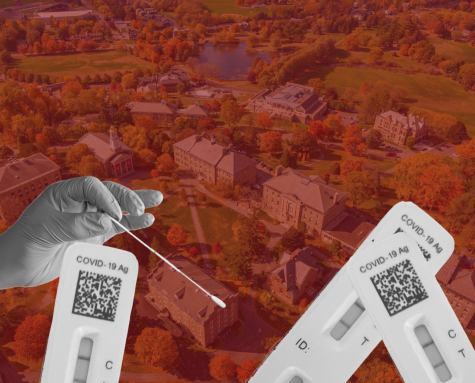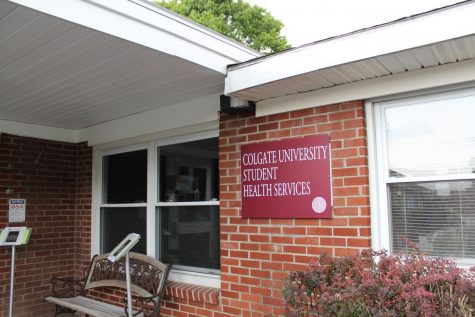Fall Semester Classes Taught Through Variety of Instruction Methods Following Universal Quarantine
After last spring semester was abruptly cut short as a result of the fast-spreading COVID-19 virus and its threat to the health and safety of the Colgate community, students have now begun the fall semester online, whether from their quarantine in Colgate residences or remotely from home.
With little time to prepare, the University was forced to move all classes online after an extended spring break in March. Online learning — via synchronous or asynchronous instruction — posed many obstacles for students. Students living in different time zones, those lacking access to strong internet connection or conducive study spaces and those who had to figure out how to travel home safely in compliance with travel restrictions faced extra hurdles to overcome in this transition.
All students began classes remotely last week, either from their residence on campus or off-campus, where they must quarantine for at least 14 days, or remotely from home. Some courses will be taught entirely remotely for the semester, and any in-person classes will again transition to being completely online after the Thanksgiving recess in November.
Between these mandatory online segments, which mark the beginning and end of the fall semester, some students studying on campus will attend in-person classes, depending on the class status decisions of individual professors, who were able to choose to teach entirely online, in-person, or a unique mix of in-person and online (hybrid). Associate Professor of Philosophy Ed Witherspoon was particularly satisfied with Colgate’s handling of class status.
“Colgate has done a very good job providing autonomy for professors to decide what is best for them. There was no pressure on professors to do one thing or another. It was made very clear that if for whatever reason we choose to teach remotely, it’s ok,” Witherspoon said. “The fact that so many professors have opted to teach hybrid or in-person reflects the overall faculty commitment to students and learning.”
Witherspoon is teaching his philosophy courses in a hybrid format. “I chose the hybrid option to give myself and my students as much flexibility as possible. I had previously considered going entirely remote for a number of reasons,” Witherspoon said.
“Going remote would have allowed me to better accommodate students who are off-campus and interested in my course,” he continued. It would have been a good safety measure to keep myself and my students safe, and would have allowed my course format to be more predictable and easy for students to follow. Ultimately, I decided to go hybrid so that I could give myself the option of in-person classes when it makes sense to have them, provided that I can do so safely and in a way that maintains social distance and in a classroom that allows for adequate ventilation.”
Professor of English Sarah Wider chose to teach remotely. She sent a statement to prepare her students for what to expect in her course, “The Female Protagonist.”
Wider emphasized the age of her husband, Bruce, an active member of the community, and the importance of his health and safety in her decision. Wider also cited her commitment to keeping the rest of her family safe from the threat of COVID-19 in teaching remotely.
“I have decided to teach the course remotely because the in-person risks feel too great …With the recent study published in the Journal of the American Medical Association showing that 78 [percent] of those who have recovered from COVID-19 continued to have heart damage after recovery … it just doesn’t make sense to try out the in-person version, and we are trying to limit the variables as much as possible. Nothing is risk free, but coming and going from campus doesn’t seem wise at this point,” Wider wrote.
Wider further explained that while she would prefer to teach in-person under normal circumstances, social distancing guidelines make some features of Zoom more appealing for her teaching methods.
“The logistics of teaching discussion based classes given the reality of what physical distancing requires did not seem promising. In class, (whether outside or in a classroom), folks would need to be so far apart that I figured we could manage the illusion of small groups discussion better via the break-out rooms,” she said.
According to Wider, several students dropped her course shortly after this notice. None contacted her with an explanation, but she suspects it is possible some students opted to take other courses which will be conducted as hybrid or in-person.
Professor of Biology and Environmental Studies Catherine Cardelús has decided to teach her courses in-person this semester, saying the decision was an easy one.
“I am an ecologist, so naturally I teach a lot of my classes outside. I feel particularly safe in this area, I know that Colgate has put together a rigorous safety protocol, and I am expecting my students to abide by these protocols. I am not in a high risk category nor do I have small children, which makes it easier for me to choose to teach in-person. I really like teaching in-person and seeing my students,” Cardelús said.
Cardelús also shared her satisfaction with the administration’s handling of class status.
“I was surprised by how open Colgate was in terms of faculty choice on this matter. It was especially helpful that we were given ample time and opportunity to decide. One factor for many professors was waiting on the decisions of our children’s schools, and we were able to wait until we heard from them before deciding on our class status. I understand that perhaps this delay was inconvenient for students, but the reality of the situation we are in often calls for unexpected change, so I’m happy that Colgate was so open to faculty needs. This flexibility allows professors to create the best possible class for their students,” Cardelús explained.
Senior Mariam Grigoryan speculated, however, that some professors chose to be in-person for other factors.
“I think it depends on whether or not the professor is new, or has been teaching awhile. I have a feeling new professors will be more willing to teach in-person, because they’ll have an easier time getting to know their students. Other reasons for teaching in-person are likely technical difficulty issues, a distraction factor for students (who can be on their phones or websites during Zoom) and also the type of class, i.e. an arts class seems difficult to manage online while a computer science course seems easy to have in a remote format,” Grigoryan explained.
When the Colgate administration announced its plans to reopen campus for in-person classes, little information was provided about the logistics of these classes, and students were not officially informed about the status of their courses (remote, hybrid, or in-person) until early August right before the first add/drop period. Ultimately, students had to decide whether or not they would be returning to campus before they knew the status of their classes.
Sophomore Ava Horn said instruction method was vital to the decisions she needed to make regarding courses.
“Class status didn’t impact my decision to come back to campus in the fall, but when I found out which classes were going to be online and which were going to be in-person, I used add/drop to switch into as many in-person classes as I could. I completely understand the need to have some online classes, but I feel I would personally learn better in an in-person setting. I am certain that I will be better able to pay attention in-person rather than in my dorm room,” explained Horn.
Junior Nicole Weiss said that while she was somewhat frustrated with the circumstances, she remains optimistic about the fall semester.
“I would have preferred to have all of my courses in-person, but I do understand if professors are concerned for their own health. The one class I have that is in-person is discussion-based, and I am curious to see how that will work out with everyone having to wear masks and sit far apart. I have a feeling that professor-student relationships will become less personalized,” she said. Despite some of her concerns, Weiss stated that class status did not affect her decisions during the add/drop period.
Both students and professors had to determine which factors they valued in their decision making process, including safety, learning environment and flexibility. Courses taught remotely may prove that the use of technology can enhance student learning and participation in a way in-person classes cannot. Perhaps, in-person courses will be able to strongly adapt to safety rules and regulations in a way that will bring students and faculty together in a meaningful way. There are many uncertainties, yet professors and students alike seem optimistic about the future.
Ani Arzoumanian is a senior from Ridgewood, NJ concentrating in neuroscience with minors in creative writing and anthropology. She volunteers as a firefighter/EMT...











